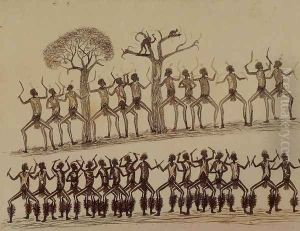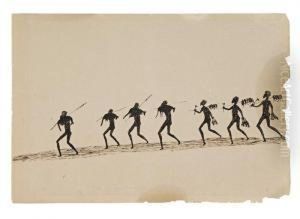Tommy McRae Paintings
Tommy McRae, also known as Tommy Barnes or Yackaduna, was a notable Aboriginal Australian artist born around 1835, near the Murray River in the southeastern part of Australia. He belonged to the Kwatkwat people, a subgroup of the Yorta Yorta nation that inhabited the Murray River region, particularly around the areas of Lake Moodemere and the junction of the Murray and Ovens rivers. McRae's work is highly significant not only for its artistic quality but also for its valuable historical and cultural insights into the lives of Aboriginal Australians during a period of intense change and colonization.
McRae's life spanned a period of dramatic transformation in Australia, marked by the encroachment of European settlers, the establishment of colonial farms, and the profound disruptions to the Indigenous way of life. Despite these challenges, McRae managed to maintain a strong connection to his culture and heritage, which is vividly reflected in his art. He worked primarily with pen and ink, creating detailed, dynamic sketches and drawings that depicted traditional Aboriginal life, ceremonies, and interactions with European settlers. His works are characterized by their narrative quality, often telling stories that blend traditional Aboriginal lore with observations of the colonial frontier.
Interestingly, McRae's art also serves as an important historical document, offering insights into the Aboriginal perspective on European colonization, including scenes of conflict and cooperation. His drawings of ceremonies, hunting scenes, and daily life provide a valuable record of Indigenous culture prior to and during early European settlement. McRae's artistic legacy is preserved in several Australian institutions, including the National Gallery of Australia and the State Library of New South Wales, among others.
Despite the challenges he faced, including the loss of his traditional lands and the pressures of living under colonial rule, McRae gained some recognition during his lifetime. He sold his drawings to settlers and visitors, which provided him with a modest income. Today, Tommy McRae is celebrated as one of the most important Indigenous Australian artists of the 19th century, not only for his unique artistic style but also for his ability to capture a critical period in Australian history through an Indigenous lens. He passed away in 1901, leaving behind a body of work that continues to be admired for its artistic merit and historical significance.

